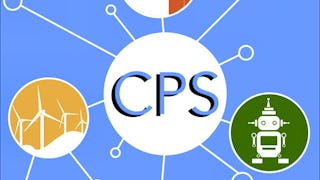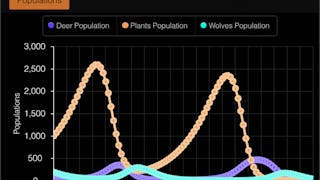This course gives you an introduction to modeling methods and simulation tools for a wide range of natural phenomena. The different methodologies that will be presented here can be applied to very wide range of topics such as fluid motion, stellar dynamics, population evolution, ... This course does not intend to go deeply into any numerical method or process and does not provide any recipe for the resolution of a particular problem. It is rather a basic guideline towards different methodologies that can be applied to solve any kind of problem and help you pick the one best suited for you.


Simulation and modeling of natural processes



Instructors: Bastien Chopard
47,015 already enrolled
Included with
(405 reviews)
Skills you'll gain
Details to know

Add to your LinkedIn profile
19 assignments
See how employees at top companies are mastering in-demand skills

There are 8 modules in this course
This module gives an overview of the course and presents the general ideas about modeling and simulation. An emphasis is given on ways to represent space and time from a conceptual point of view. An insight of modeling of complex systems is given with the simulation of the grothw and thrombosis of giant aneurysms. Finally, a first class of modeling approaches is presented: the Monte-Carlo methods.
What's included
7 videos1 reading1 assignment
This module intends to provide the most basic concepts of high performance computing used for modeling purposes. It also aims at teaching the basics of Python 3 which will be the programming language used for the quizzes in this course.
What's included
12 videos2 readings3 assignments
Dynamical systems modeling is the principal method developed to study time-space dependent problems. It aims at translating a natural phenomenon into a mathematical set of equations. Once this basic step is performed the principal obstacle is the actual resolution of the obtained mathematical problem. Usually these equations do not possess an analytical solution and advanced numerical methods must be applied to solve them. In this module you will learn the basics of how to write mathematical equations representing natural phenomena and then how to numerically solve them.
What's included
9 videos3 readings3 assignments
This module defines the concept of cellular automata by outlining the basic building blocks of this method. Then an insight of how to apply this technique to natural phenomena is given. Finally the lattice gas automata, a subclass of models used for fluid flows, is presented.
What's included
7 videos2 readings2 assignments
This module provides an introduction to the lattice Boltzmann method, a powerful tool in computational fluid dynamics. The lesson is practice oriented and show, step by step, how to write a program for the lattice Boltzmann method. The program is used to showcase an interesting problem in fluid dynamics, the simulation of a vortex street behind an obstacle.
What's included
8 videos1 reading4 assignments
A short review of classical mechanics, and of numerical methods used to integrate the equations of motions for many interacting particles is presented. The student will learn that the computational expense of resolving all interaction between particles poses a major obstacle to simulating such a system. Specific algorithms are presented to allow to cut down on computational expense, both for short-range and large-range forces. The module focuses in detail on the Barnes-Hut algorithm, a tree algorithm which is popular a popular approach to solve the N-Body problem.
What's included
6 videos1 reading2 assignments
In this module, we will see an alternative approach to model systems which display a trivial behaviour most of the time, but which may change significantly under a sequence of discrete events. Initially developed to simulate queue theory systems (such as consumer waiting queue), the Discrete Event approach has been apply to a large variety of problems, such as traffic intersection modeling or volcanic hazard predictions.
What's included
6 videos1 reading2 assignments
Agent Based Models (ABM) are used to model a complex system by decomposing it in small entities (agents) and by focusing on the relations between agents and with the environment. This approach is derived from artificial intelligence research and is currently used to model various systems such as pedestrian behaviour, social insects, biological cells, etc.
What's included
6 videos1 reading2 assignments
Instructors



Offered by
Explore more from Research Methods
 Status: Preview
Status: PreviewLudwig-Maximilians-Universität München (LMU)
 Status: Preview
Status: PreviewUniversity of California, Santa Cruz
 Status: Free Trial
Status: Free TrialUniversità di Napoli Federico II
Why people choose Coursera for their career




Learner reviews
405 reviews
- 5 stars
52.09%
- 4 stars
32.83%
- 3 stars
8.64%
- 2 stars
3.70%
- 1 star
2.71%
Showing 3 of 405
Reviewed on Jul 30, 2020
The course was really interesting and enlightening. The course gave me further understanding of important concepts I had been exposed to as well as new concepts.
Reviewed on Apr 17, 2018
Excellent course for people who love math, physics and simulations ! I choose it to get an insight on Lattice Boltzmann Method, I was happy to apply it and extend it to other cases.
Reviewed on Sep 22, 2023
Great content and lots of examples. However, some assignments and quizzes need to be updated, as well as instructions and feedback for wrong answers.

Open new doors with Coursera Plus
Unlimited access to 10,000+ world-class courses, hands-on projects, and job-ready certificate programs - all included in your subscription
Advance your career with an online degree
Earn a degree from world-class universities - 100% online
Join over 3,400 global companies that choose Coursera for Business
Upskill your employees to excel in the digital economy
Frequently asked questions
To access the course materials, assignments and to earn a Certificate, you will need to purchase the Certificate experience when you enroll in a course. You can try a Free Trial instead, or apply for Financial Aid. The course may offer 'Full Course, No Certificate' instead. This option lets you see all course materials, submit required assessments, and get a final grade. This also means that you will not be able to purchase a Certificate experience.
When you purchase a Certificate you get access to all course materials, including graded assignments. Upon completing the course, your electronic Certificate will be added to your Accomplishments page - from there, you can print your Certificate or add it to your LinkedIn profile.
Yes. In select learning programs, you can apply for financial aid or a scholarship if you can’t afford the enrollment fee. If fin aid or scholarship is available for your learning program selection, you’ll find a link to apply on the description page.
More questions
Financial aid available,



